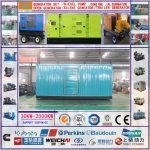Ensuring Safety Standards of Diesel Generators A Comprehensive Guide
Introduction Diesel generators are essential power sources in various industries, facilities, and locations where a reliable and independent power supply is required. While https://www.lkpowerplant.com/product/special-offer-reliable-high-power-200kw-efficient-diesel-generator-set-for-industrial-use/ provide a valuable backup during power outages, they also pose certain safety risks if not operated and maintained correctly. It is crucial for organizations and individuals utilizing diesel generators to adhere to safety standards to prevent accidents and ensure the efficient and safe operation of these power sources. In this article, we will explore the importance of safety standards for diesel generators, common risks associated with their use, and guidelines for maintaining a safe operating environment. Importance of Safety Standards Safety standards for diesel generators are established to protect individuals, property, and the environment from potential hazards associated with their operation. These standards provide guidelines and best practices that help in minimizing risks, preventing accidents, and ensuring compliance with regulatory requirements. Adhering to safety standards not only safeguards the well-being of personnel working with diesel generators but also helps in avoiding costly damages and downtime due to accidents or equipment failures. Common Risks Associated with Diesel Generators 1. Fire Hazards: Diesel generators contain flammable fuel, lubricants, and electrical components that can pose a significant fire risk if not properly maintained or operated. Fuel leaks, overheating, short circuits, and improper ventilation are common causes of fires in diesel generators. 2. Electrical Hazards: Diesel generators produce high voltages that can cause electric shocks and electrocution if proper safety precautions are not followed. Improper grounding, exposed wiring, and inadequate insulation are some of the factors that can lead to electrical accidents. 3. Carbon Monoxide Poisoning: Diesel generators emit carbon monoxide, a colorless and odorless gas that is highly toxic when inhaled in high concentrations. Improper ventilation, inadequate exhaust systems, and enclosed spaces can increase the risk of carbon monoxide poisoning. 4. Fuel Spillage and Contamination: Diesel fuel is a hazardous substance that can cause environmental pollution and health risks if spilled or leaked from a generator. Improper fuel handling, storage, and refueling practices can lead to fuel contamination and environmental damage. 5. Mechanical Failures: Components of diesel generators, such as engines, alternators, and cooling systems, are prone to wear and tear over time. Neglected maintenance, faulty components, and operational errors can result in mechanical failures that may lead to accidents or equipment breakdowns. Guidelines for Ensuring Safety Standards of Diesel Generators 1. Installation and Location: – Install diesel generators in well-ventilated and designated areas away from combustible materials and sources of ignition. – Ensure proper grounding and electrical connections to prevent electric shocks and short circuits. – Comply with local building codes, zoning regulations, and safety standards for generator installation. 2. Maintenance and Inspection: – Establish a routine maintenance schedule for diesel generators, including regular checks of fuel levels, oil levels, coolant levels, and battery condition. – Conduct thorough inspections of generator components, wiring, and connections to identify and address potential issues before they escalate. – Keep a record of maintenance activities, repairs, and replacements to track the generator's performance and compliance with safety standards. 3. Fuel Handling and Storage: – Store diesel fuel in approved containers and tanks that are designed for flammable liquids and meet safety standards. – Implement spill containment measures, such as secondary containment systems and spill kits, to prevent fuel leaks and minimize environmental impact. – Train personnel on proper fuel handling procedures, including refueling, fuel quality testing, and emergency response protocols in case of spills or leaks. 4. Exhaust Emissions and Ventilation: – Install exhaust systems and ventilation equipment to disperse exhaust gases, including carbon monoxide, away from occupied spaces and workers. – Regularly inspect and maintain exhaust systems to ensure proper functioning and compliance with emission regulations. – Monitor carbon monoxide levels in and around generator areas using gas detectors and alarms to alert personnel of potential hazards. 5. Operator Training and Safety Procedures: – Provide comprehensive training to operators and maintenance personnel on safe practices for operating, maintaining, and troubleshooting diesel generators. – Develop and implement emergency response plans, evacuation procedures, and safety protocols in case of generator malfunctions, fires, or other emergencies. – Equip personnel with personal protective equipment (PPE) such as gloves, goggles, and respirators to minimize exposure to hazards associated with diesel generators.  Conclusion Adhering to safety standards is paramount when it comes to the operation and maintenance of diesel generators to prevent accidents, protect personnel, and ensure the reliability of power supply. By following guidelines for installation, maintenance, fuel handling, ventilation, and operator training, organizations can create a safe operating environment for diesel generators. Regular inspections, monitoring, and compliance with regulatory requirements are essential aspects of maintaining safety standards and preventing potential risks associated with diesel generator use. Prioritizing safety in the operation of diesel generators not only safeguards lives and property but also enhances the efficiency and longevity of these critical power sources.
Conclusion Adhering to safety standards is paramount when it comes to the operation and maintenance of diesel generators to prevent accidents, protect personnel, and ensure the reliability of power supply. By following guidelines for installation, maintenance, fuel handling, ventilation, and operator training, organizations can create a safe operating environment for diesel generators. Regular inspections, monitoring, and compliance with regulatory requirements are essential aspects of maintaining safety standards and preventing potential risks associated with diesel generator use. Prioritizing safety in the operation of diesel generators not only safeguards lives and property but also enhances the efficiency and longevity of these critical power sources.